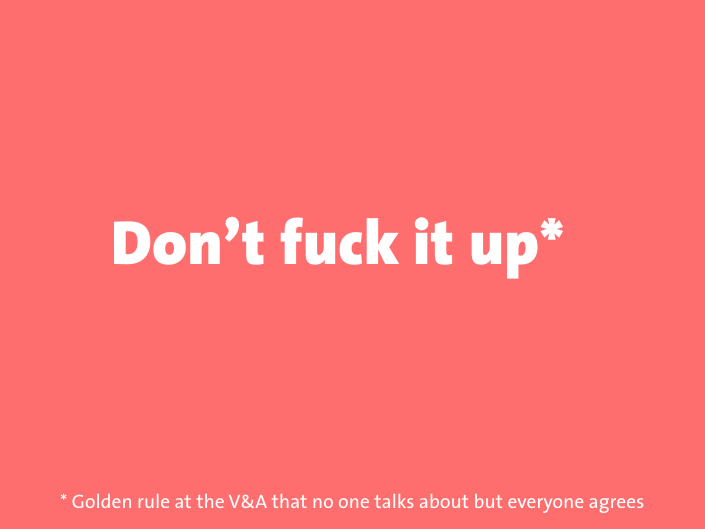Sharing how a product comes together
Last year I was a speaker at JAM London, the product-makers’ conference. I was sharing the story of shipping the new ‘What’s On’ on the V&A website. I wanted to share the nitty-gritty of building it, with all its challenges, old technology blockers and moments when we were tearing our hair out.
This is easier said than done. Explaining how a complex product comes together requires the audience to understand the product logic in order to follow the decisions you made. How much logic is enough logic, and when does detail become too much detail in a 20 minute talk?
With my theatre director’s hat on, I’ve put together these tips around how I shaped my product story with an audience of other product-makers.
1. Speak with your audience on a level
If you’re speaking to a room full of hundreds of product makers, it can be a bit daunting. How do you strike a balance between sounding confident enough but not preachy? For me, the rule of thumb when talking to other product people is simply – stop being clever, just share the bloody lessons learned along the way.
Ask yourself, if anyone in the audience experiences a similar product challenge in the future, what can they take from this talk that will help them navigate the situation? This question will help you frame the content you’re creating, and how you sequence the story.
2. Introduce the context
Context can be so easily underrated and missing crucial info can make the story fall to its knees very quickly. Concisely introduce yourself, your role, background, department, company and the challenges that come with it.
Is it a massive organisation with old technology like the V&A or a small lean startup that can move fast but might struggle in another way? How technical and well-versed in digital are your stakeholders? How big is your team?
Choose the right details to build the right context for your story. This will help your audience understand the product challenges as you seed them.
3. State the mission
The best way to get people to understand anything is to take them on the journey with you. Think of this as the Call to Adventure in the Hero’s journey. What is the big mission ahead of you? What problems are out there that make this mission particularly challenging? How are the stakes high? Do you need to revisit the context in order for the audience to understand just how much of a hill this will be to climb?
Once you can articulate the mission and the stakes, you’ll infuse your audience with curiosity and the’ll be left wondering if you make it or you’ll fuck up along the way. Now you’ve got their attention.
4. Recall your lack of knowledge
Don’t lose your audience by bombarding them with what you know about the product today. Start exactly where they are, and where you were at the beginning of the project. What were the things you didn’t know about the product at the start? Why was it important to understand it? How did you set out to understand it? What happened next? Show them how you’ve rolled up your sleeves and got stuck in.
Your mission starts now, and the lessons begin to take shape.
5. Share a particularly bleak moment
There’s nothing that brings audiences closer to the protagonist in a Hero’s journey than seeing them struggle – I mean really struggle. That’s not to say you should struggle on stage. In your story, share a depressingly low point in the process, and raise the stakes even further.
In my case, I had a moment of sheer panic – due to a severe lack of documentation around how our respective events programme systems integrated, I thought I’d never get to understanding the logic of the existing (and old) product infrastructure and will therefore never be able to build a new product on top of it.
Write down and state the reasons for this low point and use them as leverage to articulate your next steps. This will help you show how you battled with them.
6. The battle for the win
Here comes the really juicy part of your talk. Share with your audience how you systematically addressed and overcame the challenges. Get to the real nitty-gritty of getting stuff done, fighting everything that came your way. Go back to your context and address how you solved the problems and at what cost. Celebrate the unsung heroes who have helped you get the product launch-ready, the genius ideas your team mates had, and those who became surprise allies along the way.
Lastly, unveil how you completed your mission. Round it all off with lessons you want to pass on to your audience, summarising your journey in the process.
7. Edit and ‘chapterise’
Excellent work. Now that you’ve plotted your Hero’s journey, go back to what you’ve written down and consider the central question – how much detail is enough detail? Where are you lacking essential product information in order for the plot to remain compelling and understandable?
Share this with someone who’s a product-maker themselves, tell the story in your own words and ask for honest feedback. (In my case, it was the amazing organisers of JAM London, Mathilde and Seb.)
Edit your content and turn it into easy-to-understand chapters. Mine were these five:
The unknown
The panic
The break throughs
The launch plan
The three lessons
8. Make it visual
An obvious point, so not going to dwell on it too much, but will give a few small tips here. I like to think of my choice of images as a graphic novel – what images will help me convey the message, emotion, product info (delete as appropriate) throughout the Hero’s journey?
When it comes to product logic, try and use visual maps and easy-to-understand diagrams in particular. This will stop you from going into too much detail about how a product works. Tip: Save any screenshots of the old product front end, so that you can reveal the new shiny designs as a contrast.
9. For the love of god, rehearse
If you can, know your talk inside out, off by heart, without any prompts. If you’re like me, it’ll help you take your brain off the content while you’re battling nerves on stage. Once you’ve calmed your nerves down, you’ll be able to pay attention to the audience and how they’re responding to what you’re saying.
Do you need to change the pace? Take a moment to pause? Can you find an unexpected moment of comedy?
10. Make’ em laugh
I genuinely think there’s very few situations in life where a bit of comedy is unwelcome. Once you’ve plotted, drafted, written and rehearsed your entire talk, find a few comic moments – whether you prep them (GIFs never fail to make people laugh) or find them spontaneously once you’re up on the stage. Hearing your audience laugh is the best way to calm your nerves and start having fun with your talk.
Have you got a good product story to tell? You might want to get on the JAM team’s radar!
Watch the full talk about how I built What’s On on the V&A website at JAM London in 2017.







